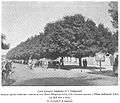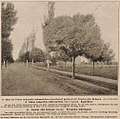Ulmus minor 'Umbraculifera'
The Field Elm cultivar Ulmus minor 'Umbraculifera' [:shade-giving] was originally cultivated in Iran, where it was widely planted as an ornamental and occasionally grew to a great size, being known there as 'Nalband' Persian: نعلبند [:the tree of the farriers][1] ("the famous 'Smithy elm' of Persia, where its dense top often forms the shelter of the native forgers"[2]). Litvinov considered it a cultivar of a wild elm with a dense crown that he called U. densa, from the mountains of Turkestan, Ferghana, and Aksu.[3] Non-rounded forms of 'Umbraculifera' are also found in Isfahan Province, Iran.[4] Zielińksi in Flora Iranica considered it an U. minor cultivar.[5]
| Ulmus minor 'Umbraculifera' | |
|---|---|
'Umbraculifera', Netherlands. | |
| Species | Ulmus minor |
| Cultivar | 'Umbraculifera' |
| Origin | Iran |
'Umbraculifera' was introduced to Europe in 1878 by the Späth nursery of Berlin, by one account from a German gardener in the employ of the Shah of Persia,[3] by another from M. Scharrer, inspector of Tiflis Imperial Gardens, Georgia.[6][7][8] It was subsequently planted along streets in Berlin.[3] Späth, along with Hesse of Weener, marketed the tree till the 1930s.[9][10][11][12]
'Umbraculifera' was introduced to the United States in 1912 as "Karagatch" (Ulmus densa syn. U. campestris [:U. minor] 'Umbraculifera') at the USDA's Chico Plant Introduction Station in California by Frank Meyer, who collected it from the Russian imperial estate at Murgrab, Turkestan (see photo taken by Meyer in 'Notable trees' below).[13]
Green mistook Späth's U. turkestanica Regel (the U. 'Turkestanica' of his Register of Cultivars[14]) for a synonym of 'Umbraculifera'.[14] Späth listed U. turkestanica Regel and U. campestris umbraculifera separately in his catalogues, where 'Umbraculifera' appears as "Ball elm. Transcaucasia, Persia. Needs no pruning. Valuable as a single tree, free-standing in park or street".[15][16][17][9]
Description
The tree is distinguished by its dense, rounded, sometimes flat-topped habit.[18][19][20] Henry's statement (1913) that "it differs from ordinary U. nitens [: U. minor] only in its peculiar habit"[3] suggests that, in one form of the tree at least, the leaf is not distinctive. A leaf-specimen labelled U. umbraculifera held in the herbarium of the Muséum National d'Histoire Naturelle appears to confirm this suggestion.[21] However, a leaf-specimen labelled U. umbraculifera Späth held in the herbarium of the Naturalis Biodiversity Center in Leiden shows that the clone marketed by the Späth nursery had a distinctive, almost rhomboidal leaf.[22] The tree is reputedly always grafted on to U. minor standards.[3] An early 20th-century photograph in Schedae ad Herbarium florae URSS (1922), shows that 'Umbraculifera' ('Bubyriana') is not dissimilar in appearance to its putative hybrid Ulmus 'Androssowii'.[23]
 'Umbraculifera', State Nursery, Campbelltown, New South Wales, 1908
'Umbraculifera', State Nursery, Campbelltown, New South Wales, 1908- Juvenile leaf of 'Umbraculifera'
 'Bubyriana' ('Umbraculifera') right, 'Androssowii' left, Samarkand (1903)
'Bubyriana' ('Umbraculifera') right, 'Androssowii' left, Samarkand (1903)
Pests and diseases
The tree is as vulnerable to Dutch elm disease as the species.
Cultivation
The tree was introduced to the Caucasus, Armenia and Turkestan,[3] and it remains in cultivation in central and south-west Asia.[4] Bean remarked that the tree succeeded well on the continent (Europe) and in eastern North America,[24] but was rarely planted in the UK.[25] Henry (1913) mentions an example at Kew Gardens, obtained in 1904 from Simon-Louis of Metz, France.[3] A specimen stood in the Ryston Hall arboretum, Norfolk,[26] in the early 20th century.[27] Introduced to Australia, the tree was marketed in the early 20th century by the Gembrook Nursery near Melbourne,[28] and by Searl's Garden Emporium, Sydney, but it is not known whether the tree survives in that country. Despite its susceptibility to Dutch elm disease, it remains in commercial cultivation in Belgium and the Netherlands.
 'Umbraculifera', Arnold Arboretum, Massachusetts, c.1900
'Umbraculifera', Arnold Arboretum, Massachusetts, c.1900 'Umbraculifera' avenue near the Späth nursery, Berlin, 1903
'Umbraculifera' avenue near the Späth nursery, Berlin, 1903 'Umbraculifera' in Germany, 1912
'Umbraculifera' in Germany, 1912.jpg) 'Umbraculifera' in Margilan, Uzbekistan
'Umbraculifera' in Margilan, Uzbekistan 'Umbraculifera', Puertollano Botanical Gardens, November
'Umbraculifera', Puertollano Botanical Gardens, November
Putative specimens in Budapest
A field elm cultivar in the People's Park, Budapest, in the early 20th century, presumably grafted at ground level and trained to a neat cone, illustrated in Möller's Deutsche Gärtner-Zeitung (1918) as Ulmus campestris als Pyramidenbaum [:field elm as pyramidal tree], may have been trimmed 'Umbraculifera'.[29]
 Trimmed field elm in Budapest, c.1917
Trimmed field elm in Budapest, c.1917
Varieties
The Field Elm cultivar Ulmus minor 'Umbraculifera Gracilis' was obtained as a sport of 'Umbraculifera' by Späth c.1897-8.[3]
Notable trees
Regel's Gartenflora (1881) contains an illustration, mentioned by Elwes and Henry in their account of 'Umbraculifera', of a great old tree near Eriwan. An avenue of dense globose trees, considered 'Umbraculifera' by Meyer at a time when the hybrid 'Androssowii' determination was unknown, once grew at the Russian imperial estate of Murgrab at Bairam-ali near Merv, formerly Russian Turkestan.[30]

 Meyer's "U. densa (U. campestris umbraculifera)" (but possibly 'Androssowii'), Murgrab near Bairam-ali (c.1912).[30]
Meyer's "U. densa (U. campestris umbraculifera)" (but possibly 'Androssowii'), Murgrab near Bairam-ali (c.1912).[30]
Synonymy
- Karagatch, also applied to Central Asian field elms generally and to the hybrid cultivar Ulmus 'Karagatch'
- Narwan: The common name for 'elm' in Persian, nār-van [:elm-tree], confusingly similar to the local name for the pomegranate, anār-van [:pomegranate-tree]. In Tehran, Umbraculifera is called nārvan-e čatrī [:canopy-like elm].[4]
- Ulmus densa var. nalband Talibov[32]
- Ulmus densa var. bubyriana: Litv., Schedae ad Herbarium Florae Rossicae 6: 163, no. 1991, t.1, 2, 1908 and Schedae ad Herbarium Florae Rossicae 8: 23, no. 2444, t. 2, 1922 resp. In the latter, Litvinov described it from a cultivated tree in Samarkand.[14]
Hybrid cultivars
- Ulmus × androssowii
Accessions
Europe
- Hortus Botanicus Nationalis, Salaspils, Latvia. Acc. no. 18147
North America
- Washington Park Arboretum, Seattle, Washington, US. Acc. no. 602-39[33][34]
Nurseries
Europe
- Boomwekerijen 'De Batterijen', Ochten, Netherlands. .
- Kwekerij Johan Van Herreweghe , Schellebelle, Belgium.
- Jacobs Plantencentrum , Venlo, Netherlands.
- Kwekerij De Reebock , Zwalm, Belgium.
- Tuincentrum Semperflorens , Roosendaal, Netherlands.
- Tuincentrum Vechtweelde , Maarssen, Netherlands.
References
- "Die grosse Herbstausstellung des Vereins zur Beförderung des Gartenbaues in der Flora zu Charlottenburg". Monatsschrift des Vereines zur Beförderung des Gartenbaues in den Königl. Preussischen Staaten für Gärtnerei und Pflanzenkunde. 21: 515. 1878.
- Descriptive Catalogue of Shady Hill Nursery, Cambridge, Massachusetts, 1893, p.3
- Elwes, Henry John; Henry, Augustine (1913). The Trees of Great Britain & Ireland. 7. p. 1893.
- Encyclopaedia Iranica, 'Elm', (6): iranicaonline.org/articles/elm
- J. Zielińksi, 'Ulmaceae', Flora Iranica, ed. K. H. Rechinger (Graz, 1979)
- "Nouveaux arbres d'ornament". La Belgique Horticole. 29: 269. 1879.
- "Beachtenswerte neue einführungen". Hamburger Garten- und Blumenzeitung. 35: 2–3. 1879.
- "Notes". Garden and Forest. 2: 516. 1889.
- Katalog (PDF). 108. Berlin, Germany: L. Späth Baumschulenweg. 1902–1903. pp. 132–133.
- Späth, Ludwig (1930). Späth-Buch, 1720-1930. Berlin: Self published. pp. 311–313, 351–352.
- Hesse, Hermann Albert (1932). Preis- und Sortenliste. pp. 96–97. Retrieved 18 January 2018.
- Hesse, Hermann Albert (1933). Preis- und Sortenliste. pp. 91–92. Retrieved 27 February 2018.
- Meyer, F. N. (1912). Seeds and plants imported during the period from January 1 to March 31, 1912: Inventory No.30, Nos 32829–32831. Bureau of Plant Industry - Bulletin No. 282. Washington, Government Printing Office, 1913.
- Green, Peter Shaw (1964). "Registration of cultivar names in Ulmus". Arnoldia. Arnold Arboretum, Harvard University. 24 (6–8): 41–80. Retrieved 16 February 2017.
- Späth, L., Catalogue 79 (1890-91; Berlin), p.114
- Späth, L., Catalogue 89 (1892-93; Berlin), p.116
- Späth, L., Catalogue 104 (1899–1900; Berlin), p.134
- Photograph of 'Umbraculifera', arnoldia.arboretum.harvard.edu, 1941, p.74
- Wyman, Donald (1951). "Elms grown in America" (PDF). Arnoldia. Arnold Arboretum, Harvard University. 11 (12): 87. Retrieved 12 October 2016.
- Ulmus minor 'Umbraculifera' photographs, Michigan State University Plant Encyclopedia
- Muséum national d’Histoire naturelle, Paris (France). Collection: Vascular plants (P). Specimen P06880335
- "Herbarium specimen - L.1590678". Botany catalogues. Naturalis Biodiversity Center.
- Schedae ad Herbarium Florae Rossicae, 8: 23, no. 2445, t.2, 1922
- 'Umbraculifera' in Missouri Botanical Garden; Beilmann. A. P., 'Some Ornamental Elms', Missouri Botanical Garden Bulletin, Vol.32, No.4, April 1944; p.70
- Bean, W. J. (1981). Trees and shrubs hardy in Great Britain, 7th edition. Murray, London.
- rystonhall.co.uk/
- Ryston Hall Arboretum catalogue. c. 1920. pp. 13–14.
- Gembrook or Nobelius Nursery, Melbourne, 1918 catalogue
- Möller, Deutsche Gärtner-Zeitung, 20 February 1918
- "Ulmus densa (U. campestris umbraculifera)". Bulletin of Foreign Plant Introductions. 78: 10. 1912.
- "C. Die grosse Ulme unweit Eriwan". Gartenflora. 30: 3. 1881.
- Photo of Ulmus densa var. nalband, plantarium.ru, image 511290
- Washington Park Arboretum, depts.washington.edu
- J. C. Raulston Arboretum, Friends of the Arboretum Newsletter, Number 22, August 1991, item 25; jcra.ncsu.edu
External links
- "Herbarium specimen - E00824878". Herbarium Catalogue. Royal Botanic Garden Edinburgh. Sheet described as U. campestris umbraculifera (Späth)
- "Herbarium specimen - L.1590678". Botany catalogues. Naturalis Biodiversity Center. Sheet described as U. campestris L. f. umbraculifera Späth
- "Herbarium specimen - L.1586959". Botany catalogues. Naturalis Biodiversity Center. Sheet described as U. carpinifolia Gled. cv. 'Umbraculifera' (Trautv.)
- "Herbarium specimen - WAG.1852996". Botany catalogues. Naturalis Biodiversity Center.
- "Herbarium specimen - WAG.1853008". Botany catalogues. Naturalis Biodiversity Center.
- "Herbarium specimen - WAG.1853009". Botany catalogues. Naturalis Biodiversity Center.
- "Herbarium specimen - WAG.1853010". Botany catalogues. Naturalis Biodiversity Center. Sheet described as U. campestris umbraculifera Späth
- U. densa var. bubyriana Litvinov kiki.huh.harvard.edu
- "Ulmus campestris var. umbraculifera". Acta Horti Petropolitani. 2: 590. 1873.